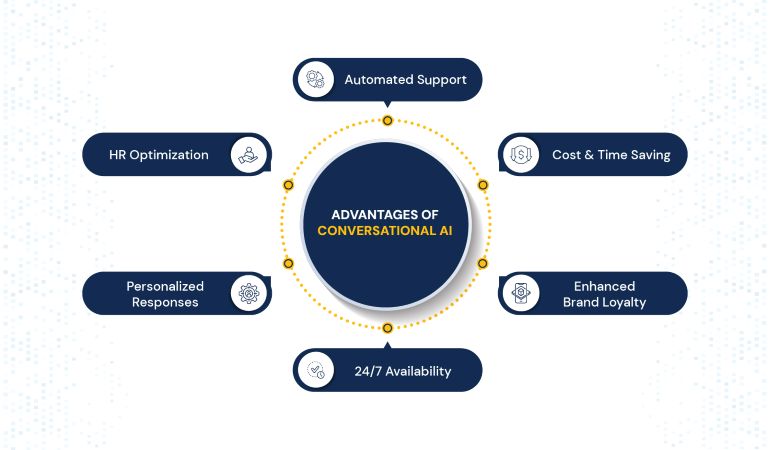Conversational AI has become widely popular today, thanks to the multiple ways businesses use it to enhance their business outcomes. Whether you want to automate repetitive tasks, offer customer service, or bolster existing IT systems, conversational AI chatbots can do it.
But what makes these virtual bots so beneficial for businesses? Let’s explore the basics of AI chatbots, their benefits, and their use cases in the enterprise world.
What is Conversational AI Technology?
Conversational AI is a technology that uses natural language processing (NLP) and machine learning to create conversational solutions. Chatbots and virtual agents can recognize, imitate, and translate human speech. In other words, it is a technology that users can talk to, for instance, through chat solutions for virtual customer service.
Conversational AI Components
Machine learning and NLP processes form a constant feedback loop, allowing the technologies to enhance AI algorithms continuously. Here’s a brief introduction to the various components used in conversational AI.
-
Machine Learning
It is a subfield of AI consisting of features, data sets, and algorithms that persistently improve with time and experience. As it grows in its learning curve, machine learning improves at pattern recognition and makes more accurate predictions based on it.
-
Natural Language Processing
NLP techniques use machine learning to analyze the language used in conversational AI chatbots. In the days before statistical NLP, language processing methodologies were limited in scope, as they dealt with linguistics, computational linguistics, and eventually statistical NLP. NLP has the following four steps.
- Input Generation – users give input to the chatbot via an application or website through speech or text.
- Input Analysis – this is where the conversational AI solution analyzes the input. For text input, it uses natural language understanding (NLU) to comprehend the meaning and intention of the input. If it’s speech-based input, the AI chatbot will use a combination of NLU and automatic speech recognition (ASR) to understand the input.
- Dialogue Management – this is the stage where the conversational AI gives a response to the user using Natural Language Generation (NLG), a key conversational AI component.
- Reinforcement Learning – this is the ML function of continuous response improvement over time.
These components give life to chatbots and virtual assistants, including traditional chatbots, that companies can use to streamline their processes and cut costs.
The advent of artificial intelligence, machine learning, and other such technologies has made it possible for businesses to interact with their customers virtually; this was impossible in earlier days. Not only can companies now communicate with their customers through virtual agents and chatbots, but they can also collect an immense amount of valuable customer data. They feed the same data into various AI-powered tools to identify patterns and customize their services accordingly, thus increasing customer satisfaction and brand loyalty.
Let’s explore the different types of conversational AI chatbots.
Different Types of Conversational AI Chatbots
-
Rule-based Chatbot
Also known as decision-tree bots, rule-based chatbots use a fixed set of guidelines or rules that determine the conversation flow. These chatbots are the most basic bots that use AI and ML solutions; they work around specific scenarios or operations and cannot jump from one conversation to another.
Rule-based chatbots are best for performing simple tasks, like responding to typical customer service queries or enabling more efficient online transactions. However, these bots do not comprehend user intent or input context, so they cannot respond to questions the programmer has not already defined.
-
Voice Bot
A voice bot is a conversational AI solution that interprets and responds to voice commands using NLP. You don’t have to write your input down; instead, you can say it out loud to your device.
You can utilize voice bots for various tasks, including answering general queries, booking appointments, and giving product information. The primary reason for voice bots’ popularity is that they make it very convenient for users to perform their tasks; they don’t have to go through cluttered menus or switch devices.
-
Intent Recognition Bot
As the name suggests, intent recognition chatbots employ machine learning algorithms to analyze user input and understand its intent. For example, if a user says, “I want to buy two tickets to Las Vegas,” the chatbot will identify the phrase and respond accordingly.
Intent recognition chatbots enable a more candid conversation since they can recognize and understand the user input much better than traditional bots or rule-based chatbots. This is because intent recognition chatbots can understand the context of the user input and, as a result, provide a much more suitable response.
-
Smart Response Chatbots
Intelligent response bots are one step ahead of intent recognition bots. These bots are capable of pattern recognition in user inputs. They identify the pattern and then give customized responses to users.
But for all this, intelligent response chatbots use natural language processing (NLP). Powerful NLP algorithms analyze user intent in detail. As a result, these bots are best used in contact centers where customers ask complex product-related questions and where understanding customer intent is vital to giving helpful and accurate responses.
The Business Advantages of Conversational AI
Conversational AI offers multiple benefits to businesses. Here are some leading advantages of using conversational AI for your business.

- Conversational AI is best known for helping companies streamline their customer service by automating it. An AI-powered chatbot uses machine learning and NLP to understand human speech or text input and respond accordingly. This allows you to deal with your customers at a fraction of the cost to run a full-fledged contact center with humans as agents.
- AI chatbots save you time and money and allow you to respond to customers more personally and naturally.
- You can use human resources for more strategic purposes by automating the entire customer service process unless there’s a case of high complexity that the chatbot cannot handle. In such cases, your virtual bot can escalate the query to a human agent.
- Chatbots offer 24/7 customer service capabilities.
- You can use machine learning algorithms to recognize patterns in customer interactions and use the insights to give tailored responses.
- Conversational AI helps you improve your brand reputation through increased customer satisfaction, retention, and brand loyalty.
Real-World Conversational AI Business Cases
It doesn’t matter which industry you belong to or your company’s size – conversational AI is there to help any business that offers customer service. New technologies like AI, machine learning, etc., are upending old structures and processes of enterprise solutions. You can now offer customer service virtually at a fraction of the cost of providing it manually through humans.
Here’s how you can use it for your enterprise:
-
Real-time Customer Service Through Automation
You can program chatbots to help users navigate a website or an online store, answer frequently asked questions, understand the products, and more. Automating these tasks means that your customers will get answers to their questions immediately, thus improving their customer experience.
-
Tailored Interactions and Improved Engagement
Another way you can use chatbots is to give personalized responses to your customers. Tailored interactions have another key benefit: they increase customer engagement, retention, loyalty, and satisfaction. All these are vital for a company to succeed in a highly competitive business environment.
-
Leverage Business Intelligence Using Conversation Analysis
Conversation analysis (CA) is an incredible data analytics approach that analyzes conversations to generate customer insights. Instead of merely looking at the number of website visits, bounce rates, click-through rates, etc., you can explore how customers interact with you to help you develop personalized responses that meet their needs.
Here is a list of industries that use conversational AI.
- Healthcare
- Gaming
- Hospitality
- Education and social/public services
- Real estate
- Insurance
- Restaurant
- Airline
- Banking
- Technology
How To Implement Conversational AI in Your Business
Implementing conversational AI for business requires a carefully thought-out approach. For successful integration into your business, follow these steps:
-
Determine Areas of Integration
Some areas within a business can better take advantage of conversation AI than others. For proper implementation, start identifying areas that can benefit the most. However, you must also consider how automation will impact your business operations.
Some common areas that are suited for conversational systems in businesses include:
- Customer Support
- Human Resource
- Help Desks
- Marketing and Sales
- Retail
- Finance Management
-
Select the Right Solution
The conversational AI solution should align with your business goals and resources. Here are some factors that you should consider:
- Level of Customization
- Future Growth
- Ease of Integration
- Compatibility
You should thoroughly test the AI system before making a choice. It will help you identify any issues preemptively and ensure that AI functions are relevant to your needs.
-
Don’t Compromise on Security
Data security and compliance must be your top priority during AI implementation. Use strong security measures to protect data and sensitive information from malicious actors. Here are some of the measures you can take to ensure data security:
- Encryption
- Regular Audits
- Secure Logins
- Compliance Checks
-
Train Your Team
Once the AI solution is implemented, your business team will manage it. Therefore, you must ensure they are adept at using conversational systems in business operations and provide them with constant training and support.
-
Keep it Customer-focused
The conversational AI should be easy to use for your customers, so design it with the user in mind and keep the interface as simple as possible.
Moreover, collect regular feedback to understand how customers interact with your AI solution. Based on the feedback, make changes and adjustments to align your AI tools with real-world conditions.
The Future of Conversational AI in Business
The future of conversational AI in enterprises is bright, with the possible uses of conversational systems in businesses increasing over time. AI-powered tools will become better at analyzing conversational data to drive more profound insights into customer preferences and behaviors. Chatbots will also become more human-like when engaging in conversations with customers.
Furthermore, conversational AI has the potential to integrate with other emerging technologies, such as virtual and augmented reality. Finally, conversational AI will increase users’ ability to interact with multiple languages, allowing them to understand diverse cultural contexts.
Conclusion
In a world rapidly undergoing digitization, conversational AI chatbot technology is a must for businesses seeking to retain a competitive edge. Artificial intelligence, machine learning, NLP, etc., have revolutionized almost every aspect of how companies go about their businesses.
If you want to build a conversational AI chatbot specific to your business needs, contact us at [email protected].

